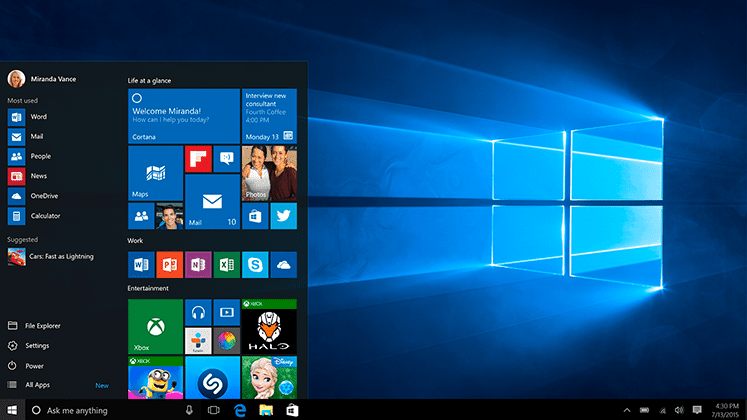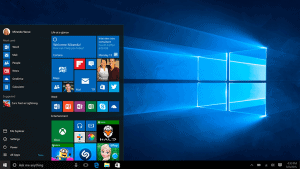Windows 10: Should I upgrade?
On 29th July 2015, Microsoft began the consumer roll-out of Windows 10. According to an article on The Inquirer, just over a month after the roll-out began, Windows 10 already had a market share of 8.45% in Britain (5.64% in the US and 4.88% worldwide).
If you’re currently using Windows 7 or Windows 8/8.1, it’s free to upgrade until 29th July 2016. If you upgrade after this date, or if you are using an older operating system then you will have to pay. If you’re unsure but still want to give it a try, if you upgrade and then decide it’s not for you then you have a month to downgrade back again.
So, what’s so good about Windows 10?
There are a number of good things about Windows 10 that makes it a huge improvement on the unpopular release of Windows 8 (Windows 10 starts faster and uses less memory) and it shows that Microsoft have taken notice of consumer feedback. They have basically taken the foundations of Windows 7 and added some of the good aspects included in Windows 8, but left out or fine tuned the stuff that nobody liked (such as the “tiled” start screen and dual desktop setups). All in all it is a good mix and miles better than Windows 8.1. Here are four features that are likely to get people most excited:
- The return of the Start Menu – if you are using Windows 8 and lamenting the loss of the Start Menu then rest assured that it is back with Windows 10. It may look different to the old Start Menus, but it’s there. Or if you really want it to look and feel like it does it Windows 7, download a little program called Classic Shell.
- Cortana – if you have a Windows phone, you may already be familiar with virtual assistant, Cortana. Integrated into the search feature and sitting on the task bar, Cortana provides a really useful natural language search function and will trawl both your desktop and/or the internet to offer up relevant results depending upon the context of your search. You can even set it up to keep track of your appointments and reminders. It can do as much or as little as you like and if it all seems a little big brotherish for you, you can disable it.
- New ‘Edge’ browser – replacing the increasingly unpopular Internet Explorer is the new Edge browser. Don’t expect too many bells and whistles just yet as it is still in a pretty basic form, but it works and extensions are due, which will enhance functionality. We at Dunblue still recommend Chrome or Firefox.
- ‘Continuum’ mode – designed for use with hybrid devices (such as tablets with detachable keyboards), the new Continuum feature detects what way you’re using your device and acts appropriately by intelligently moving between laptop and tablet usage modes. Obviously the laptop mode is more suited to keyboard/mouse set ups with the traditional desktop layout, whereas the tablet mode is better suited for fingers.
One of the most convenient things about the upgrade to Windows 10, though, is that all of your existing data, files, documents and even your installed programs will be maintained, meaning you’re good to go as soon as the upgrade completed (make sure you take a full back up of your important files first though!).
The drawbacks of upgrading
No upgrade is ever without its downsides; you just need to weigh up what it means for you, but, for the vast majority of people, it will make sense to upgrade and, of course, Microsoft won’t support older operating systems indefinitely. Here are some of the things you might miss when you upgrade:
- Windows Media Centre has been scrapped – so if you use it to play slideshows, videos or music from your local hard drives, optical drive or network location, you will lose this functionality if you upgrade. Third party alternatives are available though.
- Windows 10 is brand new and so bugs and glitches are likely to occur – it might be worth waiting a few months so any early problems are ironed out before you upgrade, especially if you are currently using Windows 7. Windows 8 users might be happier to take the plunge early, though, as Windows 10 fixes a lot of the inadequacies found in Windows 8.
Something else to consider is, of course, do you need to upgrade to Windows 10? If you are content with using Windows 7 or maybe just not that interested in the hassle then maybe you don’t need to bother right now. If you are using Windows 8 or 8.1 right now though then we do recommend the upgrade straight away.
Overall, here at Dunblue, we are pretty impressed with Windows 10; it’s not perfect, but it is a vast improvement on Windows 8 and will get better still over time. If you’re a business user, we recommend sticking to Windows 7 for the time being, unless your IT Support provider suggests otherwise.
Remember, if you are a Windows 7 or 8 user, you have until 29th July 2016 to upgrade for free!


